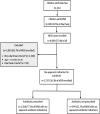Antibiotic-Prescribing Practices for Management of Childhood Diarrhea in 3 Sub-Saharan African Countries: Findings From the Vaccine Impact on Diarrhea in Africa (VIDA) Study, 2015-2018
- PMID: 37074427
- PMCID: PMC10116514
- DOI: 10.1093/cid/ciac980
Antibiotic-Prescribing Practices for Management of Childhood Diarrhea in 3 Sub-Saharan African Countries: Findings From the Vaccine Impact on Diarrhea in Africa (VIDA) Study, 2015-2018
Abstract
Background: Despite antibiotic prescription being recommended for dysentery and suspected cholera only, diarrhea still triggers unwarranted antibiotic prescription. We evaluated antibiotic-prescribing practices and their predictors among children aged 2-59 months in the Vaccine Impact on Diarrhea in Africa (VIDA) Study performed in The Gambia, Mali, and Kenya.
Methods: VIDA was a prospective case-control study (May 2015-July 2018) among children presenting for care with moderate-to-severe diarrhea (MSD). We defined inappropriate antibiotic use as prescription or use of antibiotics when not indicated by World Health Organization (WHO) guidelines. We used logistic regression to assess factors associated with antibiotic prescription for MSD cases who had no indication for an antibiotic, at each site.
Results: VIDA enrolled 4840 cases. Among 1757 (36.3%) who had no apparent indication for antibiotic treatment, 1358 (77.3%) were prescribed antibiotics. In The Gambia, children who presented with a cough (adjusted odds ratio [aOR]: 2.05; 95% confidence interval [95% CI]: 1.21-3.48) were more likely to be prescribed an antibiotic. In Mali, those who presented with dry mouth (aOR: 3.16; 95% CI: 1.02-9.73) were more likely to be prescribed antibiotics. In Kenya, those who presented with a cough (aOR: 2.18; 95% CI: 1.01-4.70), decreased skin turgor (aOR: 2.06; 95% CI: 1.02-4.16), and were very thirsty (aOR: 4.15; 95% CI: 1.78-9.68) were more likely to be prescribed antibiotics.
Conclusions: Antibiotic prescription was associated with signs and symptoms inconsistent with WHO guidelines, suggesting the need for antibiotic stewardship and clinician awareness of diarrhea case-management recommendations in these settings.
Keywords: Africa; antibiotic; children; diarrhea; prescription.
© The Author(s) 2023. Published by Oxford University Press on behalf of Infectious Diseases Society of America.
Conflict of interest statement
Potential conflicts of interest. E. L. D. reports grant funding to her institution from the National Institutes of Health (NIH; grant number T32AI007524). K. L. K. reports consultation fees and travel support from PATH and the University of Washington related to diarrheal diseases and grant support to her institution from the National Institute of Allergy and Infections Diseases, Institut Pasteur, and the Bill & Melinda Gates Foundation. M.-A. W. reports receiving funding from the Centers for Disease Control and Prevention (CDC) and the Institute of Tropical Medicine. S. M. T. reports multiple grants paid to her institution from NIH, BMGF, Wellcome Trust, Affinivax, Lumen Biosciences, PATH, and the Medical Research Council. She also reports payments as royalties related to intellectual property for Salmonella vaccines and Klebsiella/Pseudomonas vaccines and consulting fees and travel support from the University of Washington for a grant proposal. She also reports holding multiple planned, issued, and pending patents on Salmonella, Klebsiella, and Pseudomonas vaccines and hold multiple unpaid committee roles with the American Society of Tropical Medicine and Hygiene. All other authors report no potential conflicts. All authors have submitted the ICMJE Form for Disclosure of Potential Conflicts of Interest. Conflicts that the editors consider relevant to the content of the manuscript have been disclosed.
Figures

References
-
- World Health Organization/United Nations Children's Fund . Integrated Management of Childhood Illness [IMCI] handbook, 2005 technical update. Available at: https://www.who.int/maternal_child_adolescent/.documents/9241593482/en/. Accessed 20 September 2020.
-
- Hofer U. The cost of antimicrobial resistance. Nat Rev Microbiol 2019; 17:3. - PubMed
-
- World Health Organization . Antibiotic resistance. 2020. Available at: https://www.who.int/news-room/fact-sheets/detail/antibiotic-resistance. Accessed 14 November 2022.
Publication types
MeSH terms
Substances
LinkOut - more resources
Full Text Sources
Medical

